TOYOTA HIGHLANDER 2018 Owners Manual (in English)
Manufacturer: TOYOTA, Model Year: 2018, Model line: HIGHLANDER, Model: TOYOTA HIGHLANDER 2018Pages: 732, PDF Size: 14.5 MB
Page 201 of 732
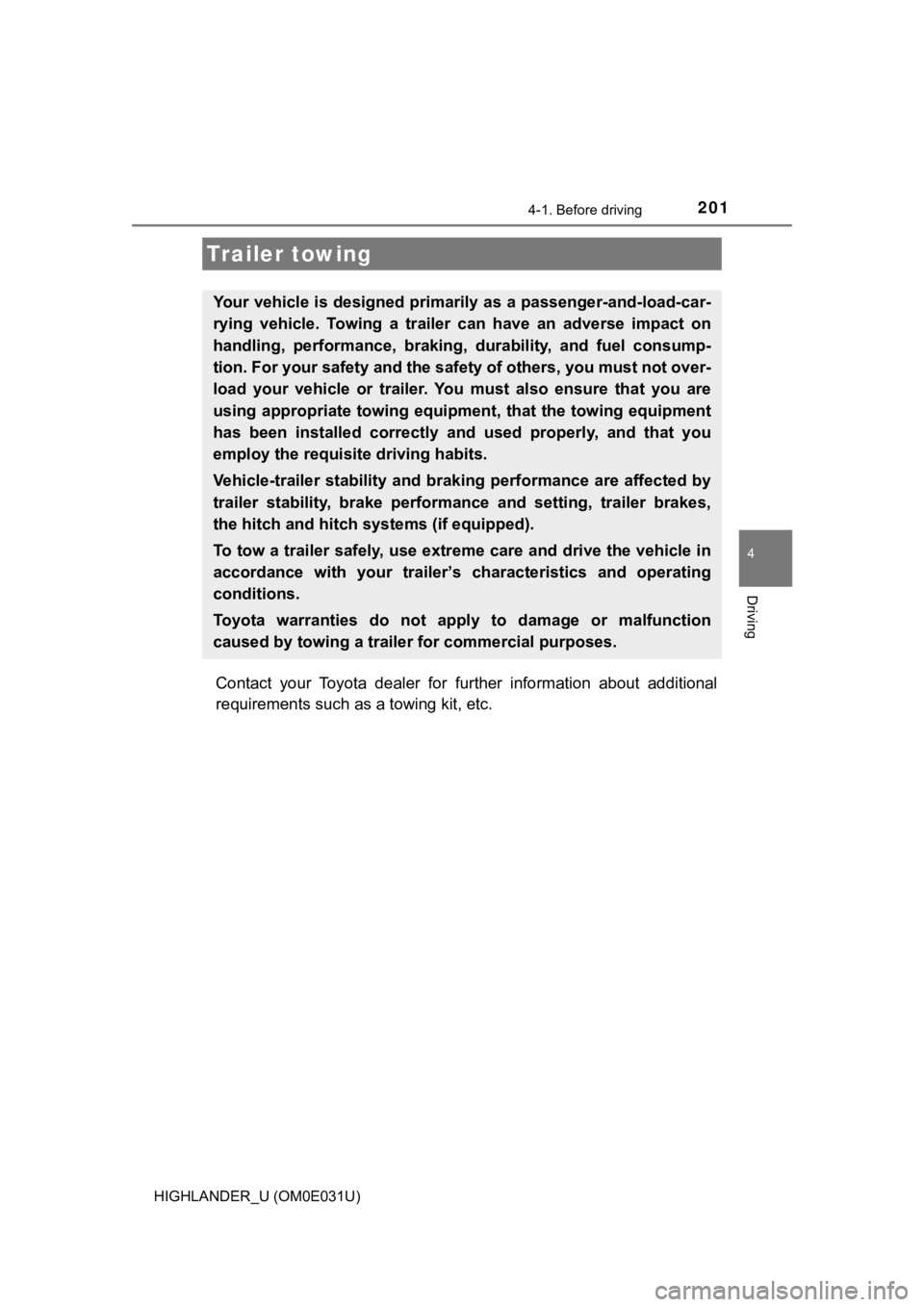
2014-1. Before driving
4
Driving
HIGHLANDER_U (OM0E031U)
Contact your Toyota dealer for further information about additi onal
requirements such as a towing kit, etc.
Trailer towing
Your vehicle is designed primarily as a passenger-and-load-car-
rying vehicle. Towing a trailer can have an adverse impact on
handling, performance, braking, durability, and fuel consump-
tion. For your safety and the safety of others, you must not ov er-
load your vehicle or trailer. You must also ensure that you are
using appropriate towing equipm ent, that the towing equipment
has been installed correctly a nd used properly, and that you
employ the requisi te driving habits.
Vehicle-trailer stability and braking performance are affected by
trailer stability, brake performance and setting, trailer brake s,
the hitch and hitch systems (if equipped).
To tow a trailer safely, use extreme care and drive the vehicle in
accordance with your trailer’s characteristics and operating
conditions.
Toyota warranties do not apply to damage or malfunction
caused by towing a trailer for commercial purposes.
Page 202 of 732
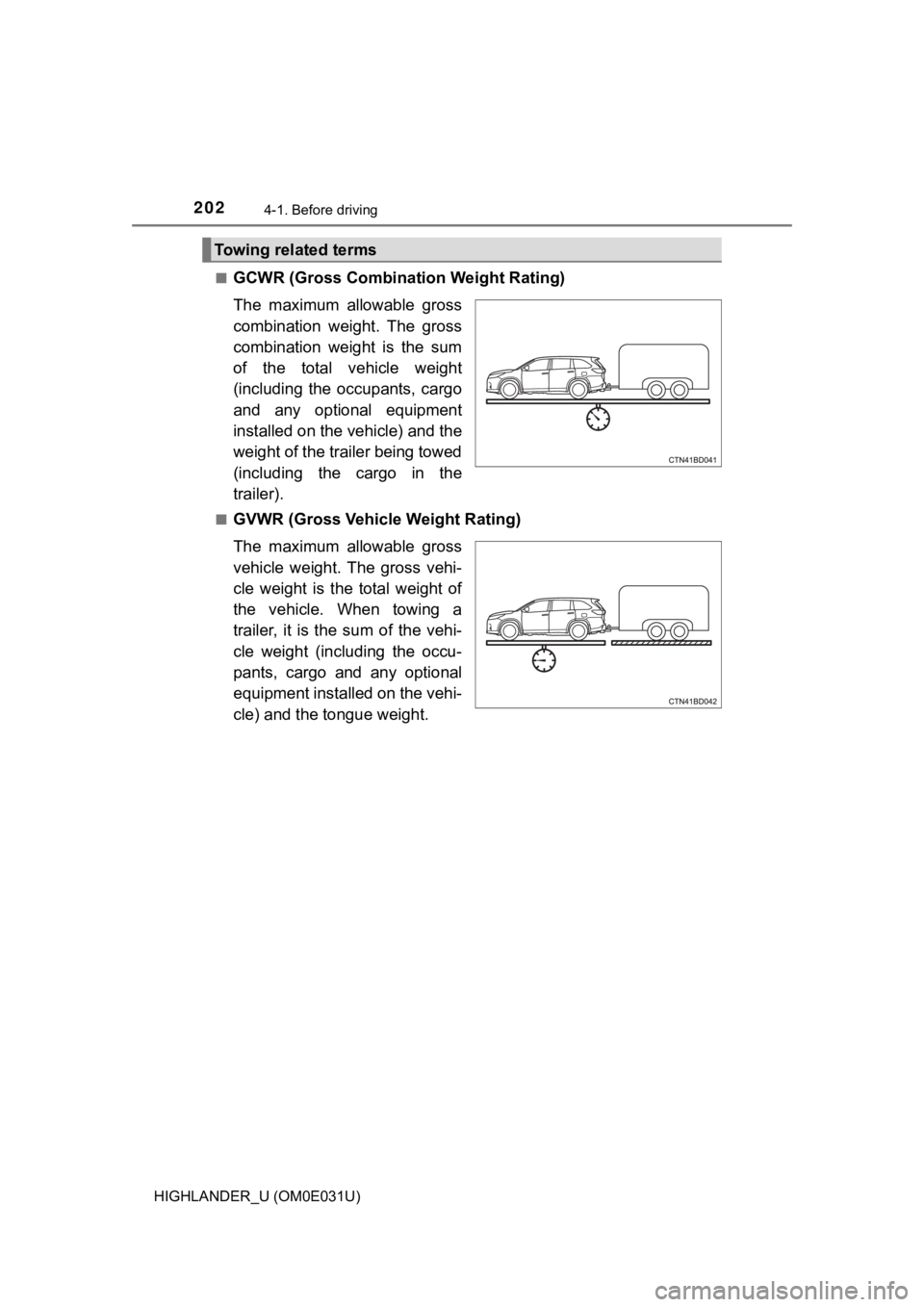
2024-1. Before driving
HIGHLANDER_U (OM0E031U)■
GCWR (Gross Combination Weight Rating)
The maximum allowable gross
combination weight. The gross
combination weight is the sum
of the total vehicle weight
(including the occupants, cargo
and any optional equipment
installed on the vehicle) and the
weight of the trailer being towed
(including the cargo in the
trailer).
■GVWR (Gross Vehicle Weight Rating)
The maximum allowable gross
vehicle weight. The gross vehi-
cle weight is the total weight of
the vehicle. When towing a
trailer, it is the sum of the vehi-
cle weight (including the occu-
pants, cargo and any optional
equipment installed on the vehi-
cle) and the tongue weight.
Towing related terms
Page 203 of 732
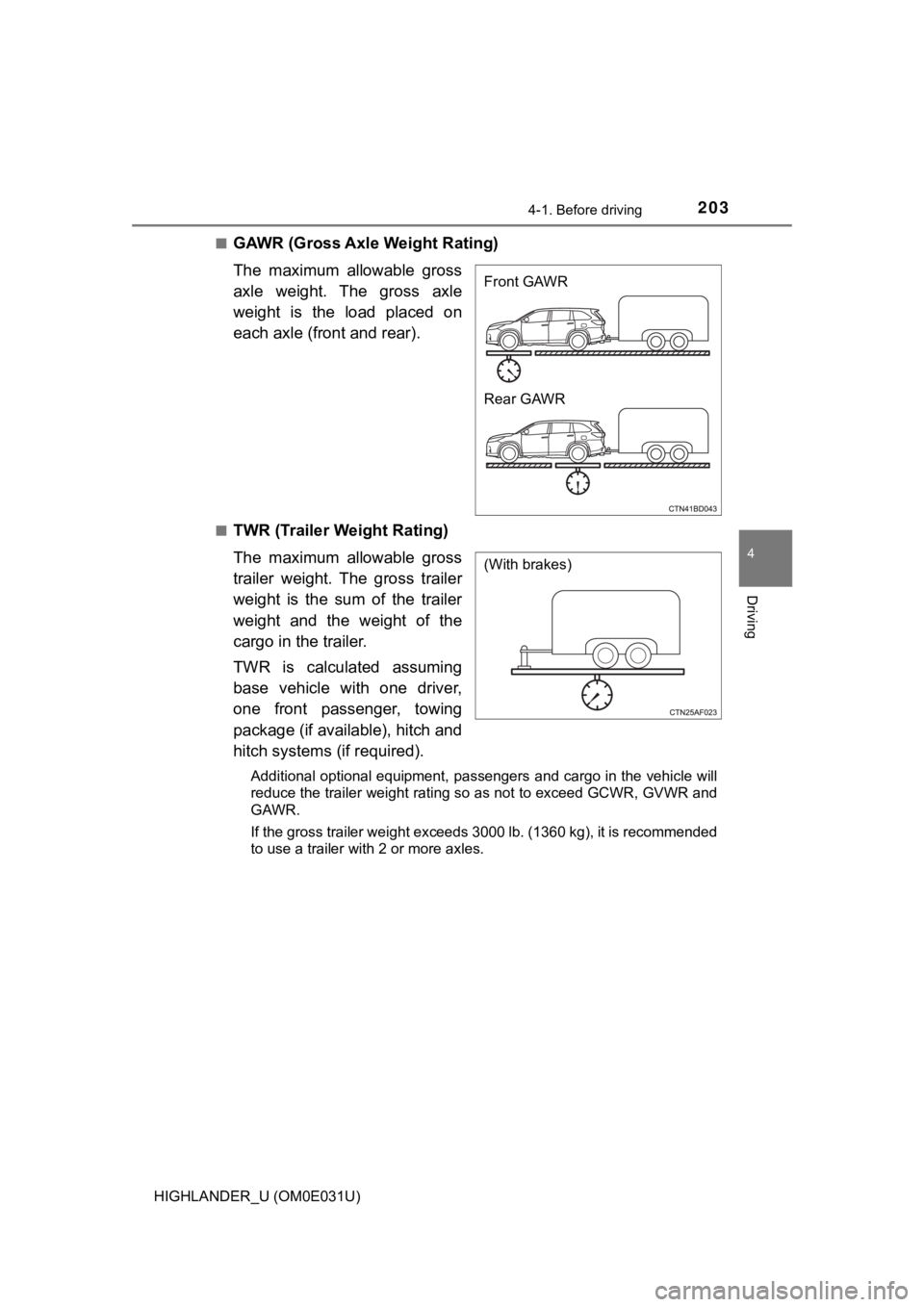
2034-1. Before driving
4
Driving
HIGHLANDER_U (OM0E031U)■
GAWR (Gross Axle Weight Rating)
The maximum allowable gross
axle weight. The gross axle
weight is the load placed on
each axle (front and rear).
■TWR (Trailer Weight Rating)
The maximum allowable gross
trailer weight. The gross trailer
weight is the sum of the trailer
weight and the weight of the
cargo in the trailer.
TWR is calculated assuming
base vehicle with one driver,
one front passenger, towing
package (if available), hitch and
hitch systems (if required).
Additional optional equipment, passengers and cargo in the vehi
cle will
reduce the trailer weight rating so as not to exceed GCWR, GVWR and
GAWR.
If the gross trailer weight exceeds 3000 lb. (1360 kg), it is r ecommended
to use a trailer with 2 or more axles.
Front GAWR
Rear GAWR
(With brakes)
Page 204 of 732
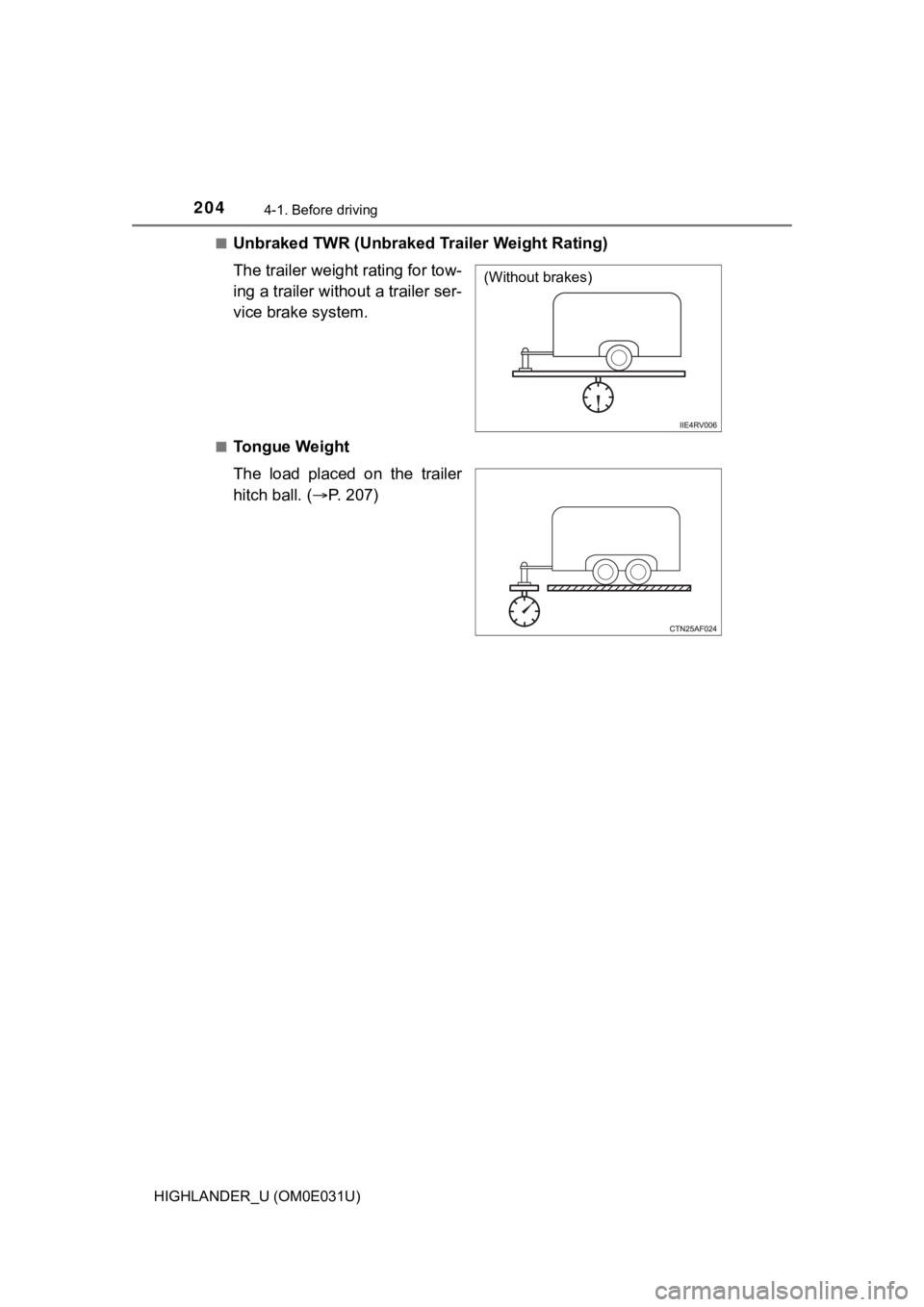
2044-1. Before driving
HIGHLANDER_U (OM0E031U)■
Unbraked TWR (Unbraked Trailer Weight Rating)
The trailer weight rating for tow-
ing a trailer without a trailer ser-
vice brake system.
■Tongue Weight
The load placed on the trailer
hitch ball. (
P. 207)
(Without brakes)
Page 205 of 732
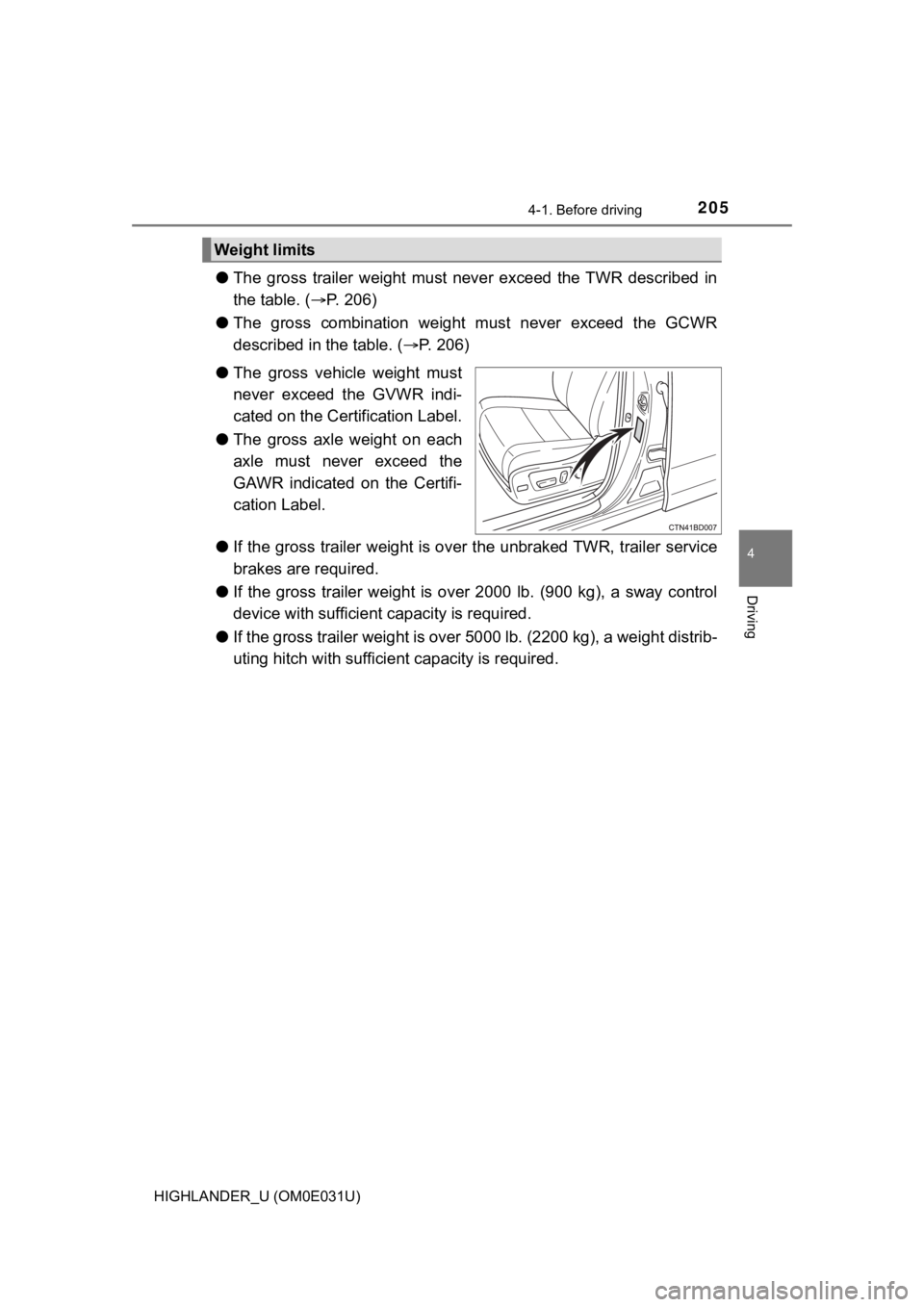
2054-1. Before driving
4
Driving
HIGHLANDER_U (OM0E031U)
●The gross trailer weight must never exceed the TWR described in
the table. ( P. 2 0 6 )
● The gross combination weight must never exceed the GCWR
described in the table. ( P. 2 0 6 )
● The gross vehicle weight must
never exceed the GVWR indi-
cated on the Certification Label.
● The gross axle weight on each
axle must never exceed the
GAWR indicated on the Certifi-
cation Label.
● If the gross trailer weight is over the unbraked TWR, trailer s ervice
brakes are required.
● If the gross trailer weight is over 2000 lb. (900 kg), a sway c ontrol
device with sufficient capacity is required.
● If the gross trailer weight is over 5000 lb. (2200 kg), a weigh t distrib-
uting hitch with suffici ent capacity is required.
Weight limits
Page 206 of 732
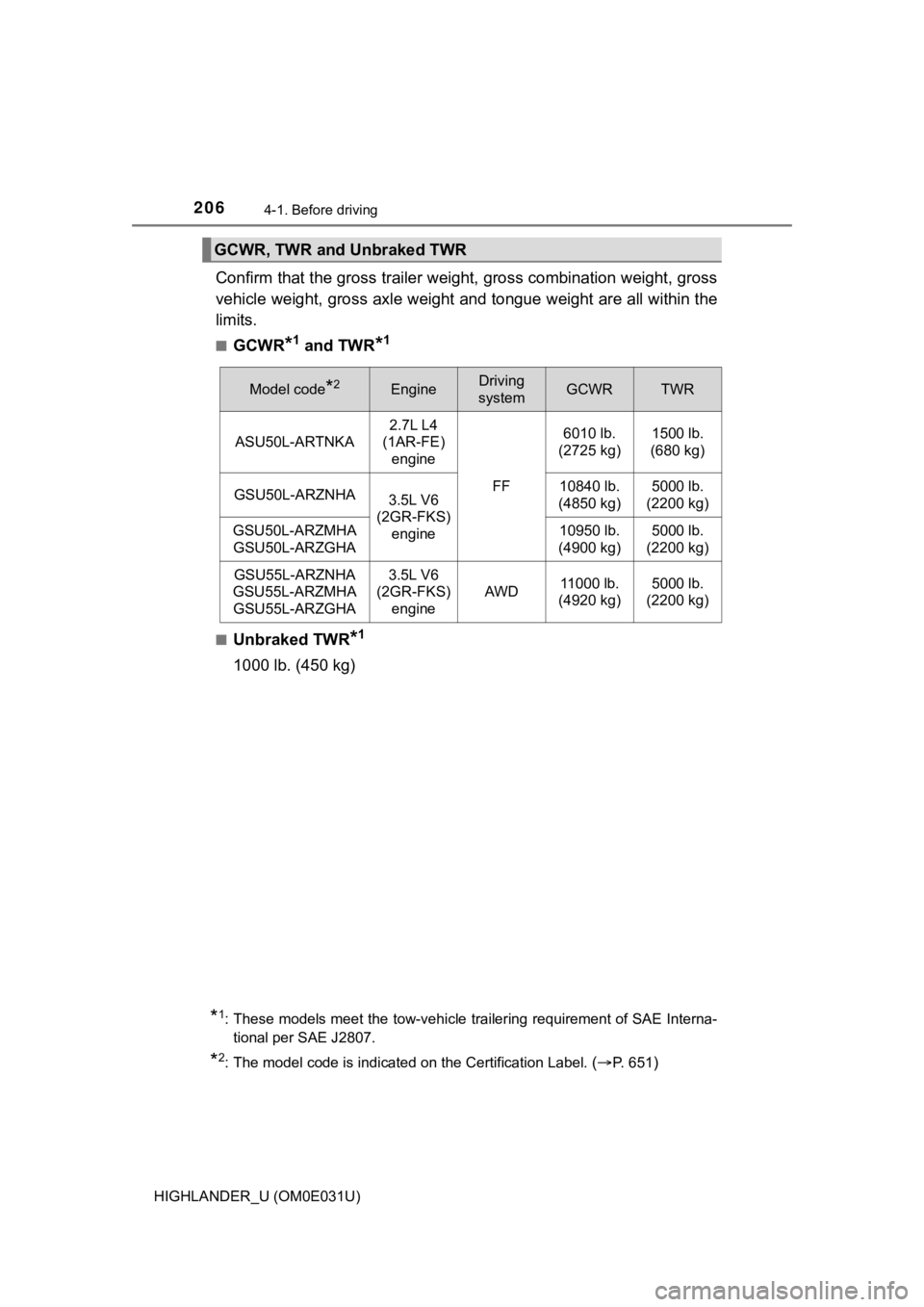
2064-1. Before driving
HIGHLANDER_U (OM0E031U)
Confirm that the gross trailer weight, gross combination weight, gross
vehicle weight, gross axle weight and tongue weight are all within the
limits.
■GCWR*1 and TWR*1
■Unbraked TWR*1
1000 lb. (450 kg)
GCWR, TWR and Unbraked TWR
Model code*2EngineDriving
systemGCWRTWR
ASU50L-ARTNKA
2.7L L4
(1AR-FE) engine
FF
6010 lb.
(2725 kg)1500 lb.
(680 kg)
GSU50L-ARZNHA3.5L V6
(2GR-FKS)
engine10840 lb.
(4850 kg)5000 lb.
(2200 kg)
GSU50L-ARZMHA GSU50L-ARZGHA10950 lb.
(4900 kg)5000 lb.
(2200 kg)
GSU55L-ARZNHA
GSU55L-ARZMHA
GSU55L-ARZGHA3.5L V6
(2GR-FKS)
engine
AWD11000 lb.
(4920 kg)5000 lb.
(2200 kg)
*1: These models meet the tow-vehicle trailering requirement of SA E Interna-
tional per SAE J2807.
*2: The model code is indicated on the Certification Label. ( P. 651)
Page 207 of 732
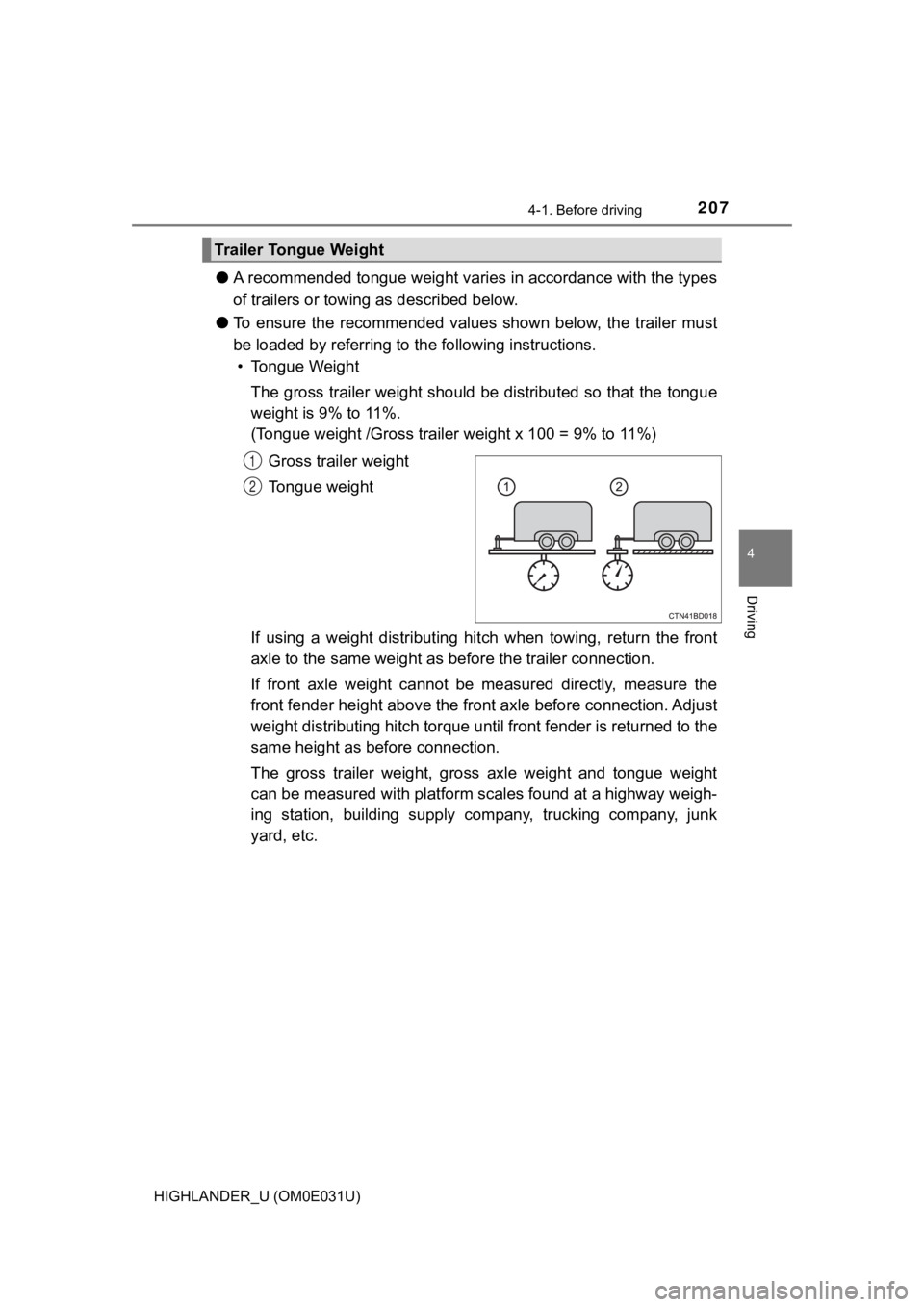
2074-1. Before driving
4
Driving
HIGHLANDER_U (OM0E031U)
●A recommended tongue weight varies in accordance with the types
of trailers or towing as described below.
● To ensure the recommended values shown below, the trailer must
be loaded by referring to t he following instructions.
• Tongue Weight
The gross trailer weight should be distributed so that the tong ue
weight is 9% to 11%.
(Tongue weight /Gross trailer weight x 100 = 9% to 11%)
Gross trailer weight
Tongue weight
If using a weight distributing hi tch when towing, return the front
axle to the same weight as b efore the trailer connection.
If front axle weight cannot be measured directly, measure the
front fender height above the front axle before connection. Adjust
weight distributing hitch torque until front fender is returned to the
same height as b efore connection.
The gross trailer weight, gross axle weight and tongue weight
can be measured with platform sca les found at a highway weigh-
ing station, building supply company, trucking company, junk
yard, etc.
Trailer Tongue Weight
1
2
Page 208 of 732
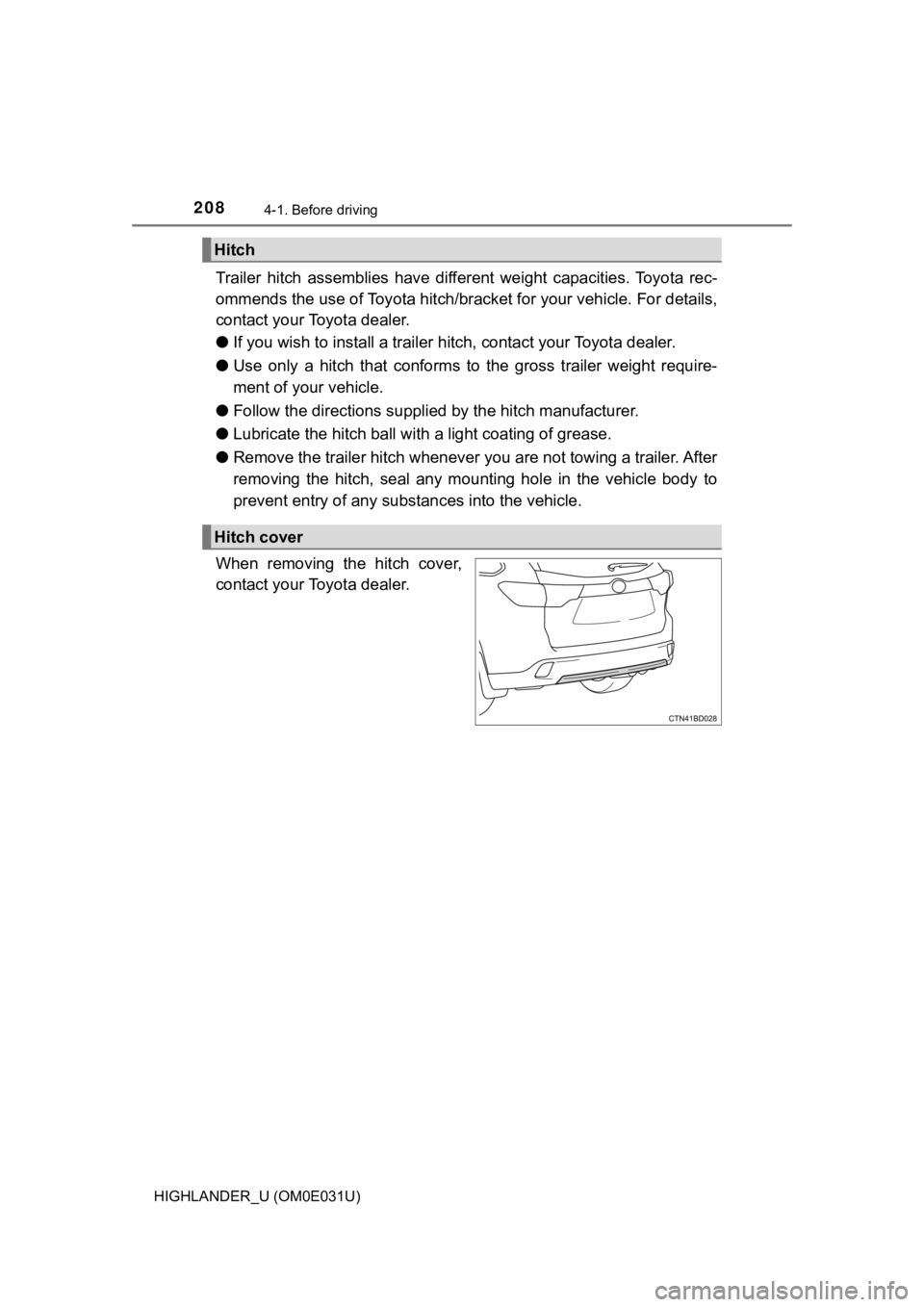
2084-1. Before driving
HIGHLANDER_U (OM0E031U)
Trailer hitch assemblies have different weight capacities. Toyota rec-
ommends the use of Toy ota hitch/bracket for your vehicle. For d etails,
contact your Toyota dealer.
● If you wish to install a trailer hitch, contact your Toyota dea ler.
● Use only a hitch that conforms to the gross trailer weight requ ire-
ment of your vehicle.
● Follow the directions suppli ed by the hitch manufacturer.
● Lubricate the hitch ball with a light coating of grease.
● Remove the trailer hitch whenever you are not towing a trailer. After
removing the hitch, seal any mounting hole in the vehicle body to
prevent entry of any substances into the vehicle.
When removing the hitch cover,
contact your Toyota dealer.
Hitch
Hitch cover
Page 209 of 732
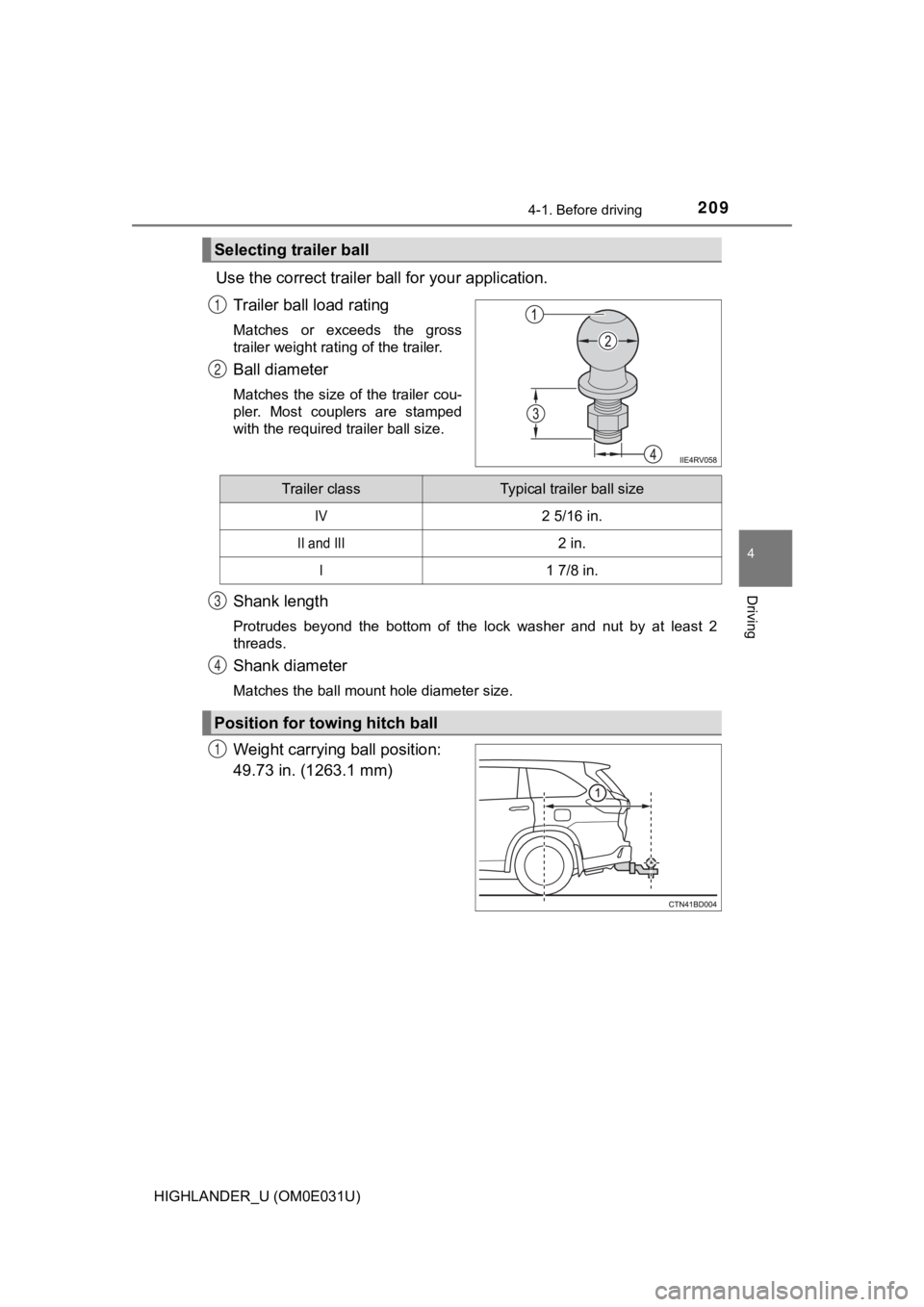
2094-1. Before driving
4
Driving
HIGHLANDER_U (OM0E031U)
Use the correct trailer ball for your application.Trailer ball load rating
Matches or exceeds the gross
trailer weight rating of the trailer.
Ball diameter
Matches the size of the trailer cou-
pler. Most couplers are stamped
with the required trailer ball size.
Shank length
Protrudes beyond the bottom of the lock washer and nut by at le ast 2
threads.
Shank diameter
Matches the ball mount hole diameter size.
Weight carrying ball position:
49.73 in. (1263.1 mm)
Selecting trailer ball
1
2
Trailer classTypical trailer ball size
IV2 5/16 in.
II and III2 in.
I1 7/8 in.
Position for towing hitch ball
3
4
1
Page 210 of 732
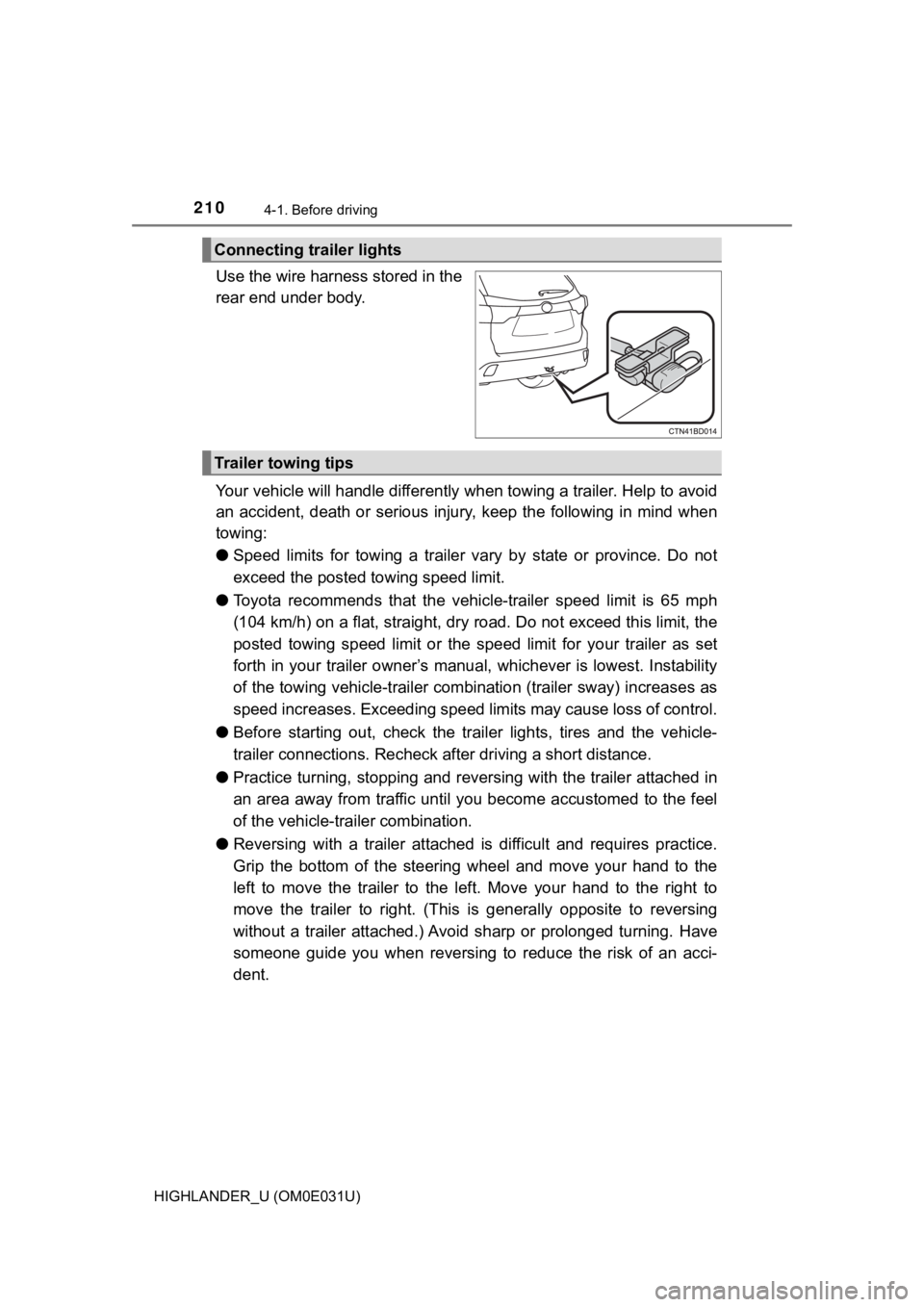
2104-1. Before driving
HIGHLANDER_U (OM0E031U)
Use the wire harness stored in the
rear end under body.
Your vehicle will handle differently when towing a trailer. Help to avoid
an accident, death or serious injury, keep the following in min d when
towing:
● Speed limits for towing a trailer vary by state or province. Do not
exceed the posted to wing speed limit.
● Toyota recommends that the vehicl e-trailer speed limit is 65 mph
(104 km/h) on a flat, straight, dry road. Do not exceed this li mit, the
posted towing speed limit or the speed limit for your trailer as set
forth in your trailer owner’s manu al, whichever is lowest. Instability
of the towing vehicle-trailer combination (trailer sway) increa ses as
speed increases. Exceeding speed limits may cause loss of contr ol.
● Before starting out, check the trailer lights, tires and the vehicle-
trailer connections. Recheck af ter driving a short distance.
● Practice turning, stopping and reversing with the trailer attac hed in
an area away from traffic until you become accustomed to the fe el
of the vehicle-trailer combination.
● Reversing with a trailer attached is difficult and requires pra ctice.
Grip the bottom of the steering wheel and move your hand to the
left to move the trailer to the left. Move your hand to the rig ht to
move the trailer to right. (This is generally opposite to reversing
without a trailer attached.) Avoid sharp or prolonged turning. Have
someone guide you when reversing to reduce the risk of an acci-
dent.
Connecting trailer lights
Trailer towing tips